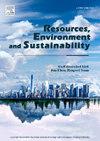Uncovering the evolution of vanadium cycle in China during 2000–2022
IF 12.4
Q1 ENVIRONMENTAL SCIENCES
引用次数: 0
Abstract
Vanadium has been classified as one critical metal by multiple countries. China has the largest vanadium reserve and production capacity in the world and plays a vital role in the global vanadium supply chain. This study aims to uncover China’s vanadium cycle and market features for the period of 2000–2022 by applying dynamic material flow analysis method. The results show that the supply of vanadium had increased more than tenfold from 2000 to 2022, with an accumulated amount of 856 Kt. The majority of vanadium were used for meeting with the domestic demand (679 Kt). Vanadium-containing steel alloys dominated the largest share (87%), while the demand for vanadium redox flow battery increased rapidly, with an average annual growth rate of 21%. Secondary vanadium resources were predominantly recovered from the slags generated from the production stage, with a smaller share from the old scraps collected from end-of-life vanadium-containing products. China mainly imported primary vanadium resources from developing countries and exported intermediate products to developed countries. However, vanadium trade was seriously disrupted by the global financial crisis in 2008 and the recent COVID-19 pandemic. Several policies are proposed to promote stable supply and sustainable utilization of vanadium resources from the perspectives of economic incentives, technological development, industrial adjustment, trade structure and strategic reserve.

2000-2022年中国钒循环演化
钒已被多个国家列为关键金属。中国拥有世界上最大的钒储量和生产能力,在全球钒供应链中发挥着至关重要的作用。本研究旨在运用动态物料流分析方法,揭示2000-2022年中国钒周期及市场特征。结果表明,从2000年到2022年,钒的供应量增加了10倍以上,累计量为856 Kt。大部分钒用于满足国内需求(679 Kt)。含钒钢合金占最大份额(87%),而含钒氧化还原液流电池需求增长迅速,年均增长率为21%。二次钒资源主要从生产阶段产生的炉渣中回收,从报废含钒产品中收集的旧废料中回收的份额较小。中国主要从发展中国家进口初级钒资源,向发达国家出口中间产品。然而,2008年全球金融危机和最近的COVID-19大流行严重扰乱了钒贸易。从经济激励、技术发展、产业调整、贸易结构和战略储备等方面提出了促进钒资源稳定供应和可持续利用的若干政策建议。
本文章由计算机程序翻译,如有差异,请以英文原文为准。
求助全文
约1分钟内获得全文
求助全文
来源期刊

Resources Environment and Sustainability
Environmental Science-Environmental Science (miscellaneous)
CiteScore
15.10
自引率
0.00%
发文量
41
审稿时长
33 days
 求助内容:
求助内容: 应助结果提醒方式:
应助结果提醒方式:


